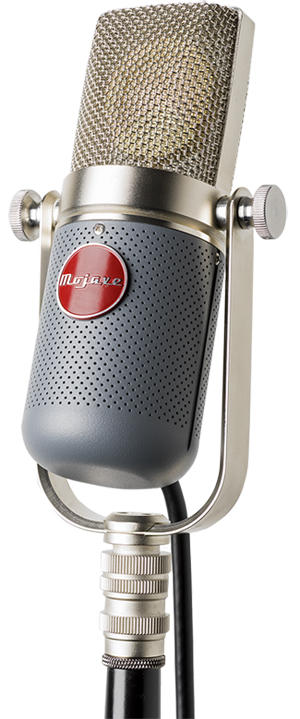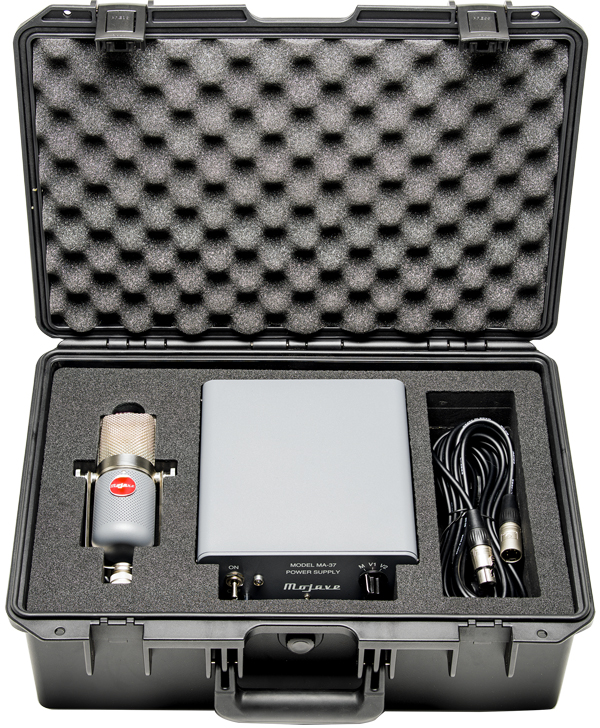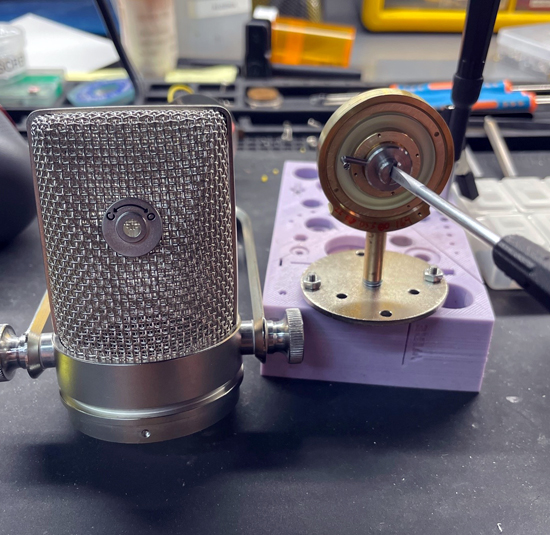
Barry's Mix Magazine Equipment And Software Reviews
Barry's Massive Discography And Engineering Career
Barry's Music Connection Magazine Reviews
Barry's Resolution Magazine Reviews
Mojave Audio MA-37
Large-Diaphragm, Tube Condenser Microphone
By Barry Rudolph
 |
| Mojave Audio MA-37 |
Designer and self-confessed Sony C-37A aficionado David Royer has fully realized his dream version of that famous microphone by way of his new Mojave Audio MA-37 largediaphragm condenser tube mic. The MA-37 embodies all the classic and quirky qualities of the original in an up-to-date, modern system with high headroom and low self-noise.
SONY C-37A
The Sony C-37A was developed in post-war Japan in 1954-55 and was initially used on symphonic recordings. Sony had started to produce semi-professional tape recorders and other audio equipment, and was interested in an alternative to the expensive German Neumann U47. The smaller C-37A was also less intrusive than the bulky U47 when used on camera for live TV performances.
The C-37A got its name from the 37-mm outside diameter of the mic's C-3 capsule. A break from the traditional dual-capsule design of the U47 and other condenser microphones at the time, the C-3 uses a single, 6-micron-thick Mylar diaphragm sputtered with a conductive 0.3-micron layer of gold; it was one of the first capsules to use DuPont's Mylar film as a diaphragm material.
Instead of Neumann's U47 amplifier circuit, based around the pricey Telefunken VF-14 triode tube, a single-stage, cathode-follower impedance converter using a 6AU6 (EF-94) pentode wired as a triode was used. (The screen and suppressor grids are tied to the plate.) The cathode-follower circuit has a gain of about 1 and requires a special output transformer to develop sufficient output gain and more headroom than is typical for most condenser microphones.
The Mojave Audio MA-37 is just like the C-37A in that it uses a mechanical "shutter" to switch its polar pattern from cardioid to omnidirectional. By either exposing or blocking holes drilled in the backplate of the capsule, the polar pickup pattern changes from an omnidirectional pressure mic when closed to a cardioid pattern when fully open. While changing patterns, you must mute the output of the mic or make the change before powering it up.
Called an adjustable tuned acoustic chamber, the technology was developed by RCA in the late 1930s for its line of Varicoustic ribbon microphones and subsequently for the 77D and 77DX models. Sony adapted it for switching between cardioid and omnidirectional polar patterns both on its C-37A mic and the very similar and now discontinued C-800 model--not to be confused with the modern Sony C-800G mic.
Imported and marketed by Los Angeles-based Superscope®, the C-37A was commercially released in the U.S. in 1958 and first shown at the Los Angeles Hi-Fi Show. It was produced until 1965.
The C-37A became popular in the 1960s in recording studios and was known for its good sound when used on most any source including vocals. The mic was actor Mel Blanc's favorite to record voices for over 400 cartoon characters including Bugs Bunny.
The Sony C-37A was often used in legendary recording sessions during the hey day of the "Wrecking Crew" at Capitol Records, Sunset Sound, and United/Western and other studios in Hollywood, CA. You might have seen the C-37A overhead of drummers Hal Blaine or Earl Palmer in vintage studio photos of those times.
MOJAVE MA-37
Mojave Audio's MA-37 uses a 37mm capsule with 6-micron Mylar diaphragm designed in California. An EF806 tube (long-plate EF86 pentode) wired as a triode is used because of their reliability, consistency and availability, as compared to the 6AU6.
The MA-37 retains much of the original's form factor and functionality, with updates to improve reliability and operation. I liked the very small holes drilled in the lower body to help keep the mic cool, and it's good to see the classic U-shaped shock-mount yoke retained.
The windscreen is made using a double layer of metal gauze, and on its backside is an access hole to toggle the shutter open and closed using a small, flathead screwdriver. Back on the front of the screen, full CCW is marked "C" for cardioid, and full CW is marked "O" for omnidirectional. Users of the original C-37A will remember these as "U" for unidirectional and "O" for omni. I used a small jeweler's screwdriver to change polar patterns; Mojave says that it will start including a screwdriver for this purpose.
The mechanical design of this screwdriver-operated switch is much better than on the C-37A, where it was sometimes a problematic point of failure. I've seen shutters used on other new mics, too, but on the MA-37, it is impossible to physically move the capsule back and forth when changing patterns.
 |
| The Mojave MA-37 comes in a hard-shell case with a 19-foot Canare cable and power supply |
MODERN POWER SUPPLY
The accompanying solid-state linear power supply is better made than the original's CP-2 unit, which has a tube rectifier inside. (It does pay homage to the original with its large, gray, cube-shaped steel box with chrome carrying handle.) All connections and controls are on the front except for the IEC power connector and 120/240 voltage mains switch on the back. The exact positioning of the chrome handle means the multi-pin, mic input XLR connector had to be mounted inverted. I like that the chrome handle makes the power supply easy to find in dark studios!
The MA-37 power supply comes with a 5.8-meter (19-foot) five-pin XLR (Canare) cable to connect power and audio to the mic's short, pigtail lead protruding out of the lower side of the mic's body. As with the C-37A, you may connect additional cable(s) in series to extend the distance between the mic and the power supply without compromise.(Check with Mojave to get an additional cable)
The output transformer is housed inside the power supply cabinet, like in the C-37A, although the MA-37 uses a newer Lundahl LL1750 output transformer. The power supply's front-panel has a power on/off toggle switch and a threeposition HPF rotary switch. Different values of Wima capacitors are switched in series with the Lundahl transformer's primary winding to engage the different HPF curves.
The M position is for flat response from 30 Hz to 18 kHz, ±3 dB; the V1 position switches in a first-order highpass filter with its -3dB point at 100 Hz; and V2 moves the frequency up to 200 Hz. These are smooth and subtle filters, definitely useful for live recordings or location work.
These filter specs differ from the vintage Sony C-37A mic; there were three different power supply variants over its lifetime with upgrades and changes to the HPF's specifications with each iteration.
Note: For recording very quiet sources such as acoustic guitars or boomy narration voice-overs in a home studio, the V1 position works best as it does not overly thin out the sound.
LET'S RECORD EVERYTHING!
My first test was recording a snare drum within a small drum kit during a tracking session. I had the MA-37 switched to M, cardioid pattern, and about 35-cm away from the snare. The producer wanted to achieve a certain overall drum sound that included bleed from the rest of the kit, so the mic was a little further away than I would usually place it.
I found that the MA-37 captured the complete ambience around the snare drum, including any quieter, subtle playing like rim accents, stick drags and the sounds coming from beneath. Even though I recorded a bottom snare mic, I doubt it will get used in the mix. Despite the mic's distance, the sound was very present, with a solid and constant midrange focus that sounded great.
Using the studio's Trident A-Range console, I immediately noticed (by the console's mic gain setting) that the MA-37's output was about the same as a modern dynamic microphone, or even Royer's R-121 ribbon mic, placed in the same position. The cathode-follower circuit, along with the Lundahl output transformer and handmade capsule, are all factors for this mic's extreme headroom capabilities, low noise and overall pleasing sound quality. Like the C-37A, the MA- 37 is now my favorite condenser snare drum mic.
 |
| Capsule Shutter Assembly |
My next use was on a rock song, recording a small, 5-watt guitar amp that I built from a kit. I switched the MA-37 to omni pattern (power supply again set to M) and placed it 7 cm away, right in front of the center of the dust cover of a Hellatone 30, 12-inch speaker in an open-back Avatar cabinet. For a less bright sound, I would move the mic outward on the cone but still keep it close. According to the manual's frequency response charts, the microphone is flatter in the bass while in omni-directional mode.
I used about 30 dB of gain from a Sunset Sound S1P "Tutti" preamp and got a clear and well-articulated rhythm guitar sound. If the amp distorts, you'll hear it immediately; all of the dynamics and color of the amp and guitar are easily captured with the MA-37. I liked that I could freely place a (usually inherently) fragile condenser mic as close or as far away as I liked--just like a more rugged dynamic.
I wanted to try the MA-37 on an orchestra instrument, and I was pleased with the sound it captured on a bassoon in a large woodwind ensemble that also included two French horns, two flutes and concert (pedal) harp. The MA-37 was in cardioid and on a boom stand aimed at the instrument's left side about halfway up and 80-cm away. About 45 dB of mic preamp gain was required from the studio's SSL Duality SE console.
Again, the entire 1.34-meter length of the instrument was well-covered, with no "hot" notes and a resultant sound that was balanced and not overly bright. There was clarity with good articulation, and the low frequencies were defined and well-heard. After recording, I could solo the track and sometimes hear the bassoon's mechanism--the whisper key, high D key, etc. but it was not an issue for the overall recording.
Next use was at a local studio with a large, vintage API console and a female singer who played piano at the same time. With the mic set in cardioid pattern, she sang about 30-cm away, sometimes wandering a little further off-mic. The MA-37 in cardioid doesn't have an excessive proximity effect and sounds very natural, with a good balance between chest and presence.
My singer sang a new (lyric) version of "America The Beautiful" using tremendous dynamic range--literally from a whisper to full-voice, big gospel-like moments. The engineer/producer didn't want to use any EQ or compression when recording, preferring to deal with it later.
The MA-37 captured it all; right down to the noise floor of the studio's live room! Loud singing moments were loud without the mic compressing or distorting. The MA-37 has smooth high frequencies and it was not sibilant at all. About 40 dB of mic gain was required from the API, and there was still plenty of headroom available.
BETTER THAN EVER
David Royer's MA-37, with its huge dynamic range, honest sound and solid utility honors the legacy of the Sony C-37A and opens up the idea of using a condenser microphone more often and on any source. It comes in a rugged, foam-lined travel case that holds the mic, cables and power supply, and it is a solid choice for anyone in the market for a new condenser studio microphone.
|
|
|
|
|